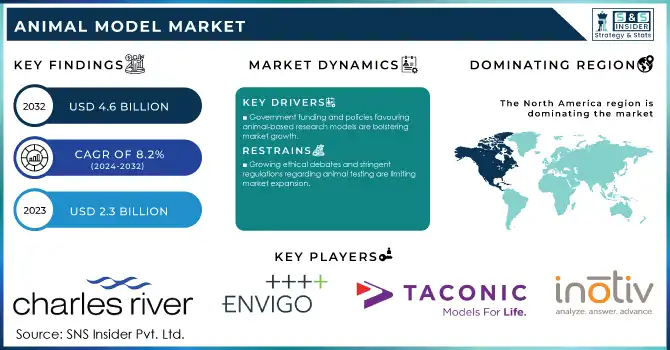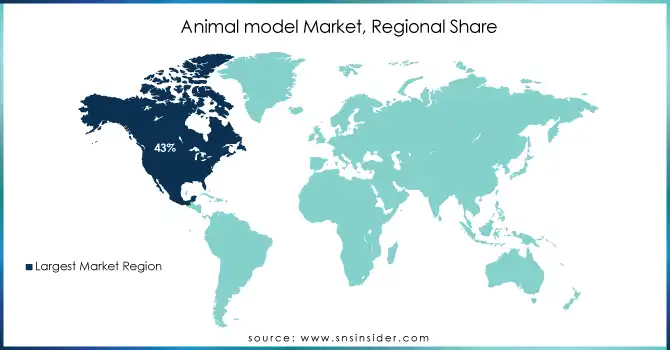Animal Model Market Size & Trends:

Get More Information on Animal Model Market - Request Sample Report
The Animal model Market Size was valued at USD 2.3 Billion in 2023 and is expected to reach USD 4.6 billion by 2032, growing at a CAGR of 8.2% over the forecast period 2024-2032.
The animal model market continues to experience significant growth, underpinned by advancements in preclinical research, increasing government funding for biomedical studies, and a rising incidence of chronic and infectious diseases globally. Governments and international organizations have consistently emphasized the critical role of animal models in accelerating medical breakthroughs and combating public health challenges. In 2023, the National Institutes of Health (NIH) allocated over $41 billion to medical research, with a substantial share directed toward studies utilizing animal models for drug development, vaccine testing, and genetic research. A specific focus was placed on zoonotic diseases, as the World Health Organization (WHO) reported that 60% of emerging infectious diseases originate from animal sources. This underscores the pivotal role of animal models in understanding disease mechanisms and developing therapeutic interventions. Furthermore, the Centers for Disease Control and Prevention (CDC) documented a 12% rise in animal model utilization for vaccine development between 2022 and 2023.
Government initiatives such as the NIH's Accelerating Medicines Partnership and the FDA's Animal Rule have further supported the integration of animal models into preclinical studies. For instance, in 2023, over 65% of preclinical trials funded by the NIH involved animal models, highlighting their centrality in biomedical research pipelines. Additionally, international funding for ethical advancements in animal research has gained momentum. The European Commission, for example, allocated €500 million under the "3Rs" initiative (Replacement, Reduction, and Refinement) to promote ethical animal testing practices and advance alternative model development.
The development of genome editing and genetic engineering tools has resulted in a revolution in the field of animal modeling. The capacity to change genes in animals allows scientists to construct models that closely resemble human diseases, resulting in more precise and accurate results. These technical improvements have increased the usability of animal models tremendously, consequently promoting market expansion. In May 2023, for example, researchers from the Massachusetts Institute of Technology devised a novel method for engineering specific cancer-linked mutations into mice models, employing the CRISPR approach to create models of diverse mutations.
Market Dynamics
Drivers
-
Technological progress in genome editing, such as CRISPR, enables the development of animal models that closely mimic human diseases, enhancing research accuracy.
-
Pharmaceutical and biotechnology companies are investing more in research and development, utilizing animal models for drug discovery and development processes.
-
Government funding and policies favouring animal-based research models are bolstering market growth.
The continuous growth of genetic engineering techniques, such as CRISPR-Cas9, is a significant driver of the animal model market. Such technologies provide accurate genome editing capabilities for the development of transgenic and knockout models reflective of human diseases previously difficult to recreate. This has transformed biomedicine, enabling improved understanding of disease mechanisms and more rational therapeutic development. In 2023, more than 70% of research in neuroscience and oncology used genetically modified mouse models, according to the National Institutes of Health (NIH). These models have been an important part of preclinical studies enabling the fast and efficient modeling of diseases such as Alzheimer several types of cancers. Additionally, CRISPR has simplified the generation of animal models, reducing development timelines from several months to a few weeks, and significantly enhancing research efficiency.
The application of these advanced models has expanded into studying rare genetic disorders. In 2024, researchers at Stanford University created a genetic mouse model for Rett Syndrome (a rare neurological condition) and discovered a new drug target. In addition, initiatives like the International Mouse Phenotyping Consortium (IMPC) have sequenced thousands of genetically modified mice and phenotyped each strain uniquely, offering powerful tools in the drug discovery paradigm. These developments guarantee that genetically engineered animal models will be an invaluable part of contemporary medical research.
Restraints:
-
Growing ethical debates and stringent regulations regarding animal testing are limiting market expansion.
-
The significant expenses associated with maintaining and utilizing animal models pose financial challenges for research institutions.
-
The development of in vitro and computational models offers alternatives to animal testing, potentially reducing demand for animal models.
The increasing realization regarding the ethical issues related to using animal models and stringent regulatory frameworks. Public sentiment against animal testing is growing, driven by awareness campaigns from animal rights organizations and advocacy for alternative research methods. While some argue that animal experiments should be stopped for ethical reasons, others debate the pain and suffering that is observed when animals are tested, and if such testing should be done at all.
Moreover, in some parts of the world, strict guidelines have been implemented by regulatory authorities to reduce animal usage in experimentation. For example, the European Union's Directive 2010/63/EU requires that the 3Rs principle (Replacement, Reduction, and Refinement) be used to limit the use of animals in research. These policies frequently result in project delays and higher bureaucracy for the researchers. These concerns and regulatory hurdles have driven the search for alternative methods, including in vitro approaches and computer models, and caused a contentious debate regarding the relevance of animal models in current science.
Segmentation Insights
By Animal Type
Due to their diverse application in biomedical research, mice accounted for the largest revenue share 51% of the animal type segment in 2023. According to the National Center for Biotechnology Information (NCBI), 75% of genes responsible for human diseases are also found in mice, making them indispensable in genetic and pharmaceutical studies. Furthermore, the Food and Drug Administration (FDA) states that mice were involved in over 65% of preclinical trials approved in 2023. These species have short generation times and are relatively inexpensive which makes them operate well in a long-term study. Another strong showing for transgenic and knockout mice research increased by 18% in 2023, further solidifying their dominance.
By Application
In 2023, the cancer segment dominated with a 41% market share due to the growing interest in cancer research. Government data from the American Cancer Society (ACS) estimates that more than 1.9 million cases of cancer will be diagnosed in 2023, bringing up the investments for novel therapies through animal models. In 2023, the NIH invested around $8 billion in cancer research, and more than 40% of these research projects use animal models. Such models are essential for studying tumorigenesis, metastasis, and drug responses. Additionally, more ethical approaches, such as OLAW-supported protocols leading to diminished animal burden, have allowed them to remain in use in cancer models.
By End-use
The pharmaceutical and biotechnology companies segment accounted for the largest market share of 38% in 2023, due to the major dependency of these companies on animal models during the drug discovery and development phase. The Biotechnology Innovation Organization (BIO) has long reviewed government statistics showing that biopharmaceutical R&D spending increased by 14% between 2022 and 2023 and that animal testing is a critical part of that process. The research eventually led to FDA approval of more than 100 drugs over ten years, nearly 60% of which had been studied in animal models before their release. This segment’s growth is further bolstered by global initiatives like the 21st Century Cures Act, which promotes the accelerated approval of breakthrough therapies, often necessitating preclinical animal studies.
Regional Analysis
North America was the leading region in 2023 with a 43% revenue share of the animal model market. A lot of government spending on biomedical research and the existence of world-leading academic and pharmaceutical companies has led to this leadership. For instance, 70% of federally funded research projects included animal models, according to a report from the U.S. Department of Health and Human Services (HHS). In 2023, the NIH also allocated an additional 15% towards translational research initiatives which contributed to continued regional growth. Canada has also refined its preclinical emphasis; in 2023, the Canadian Institutes of Health Research (CIHR) earmarked $500 million for the advancement of new animal models.
On the other hand, the highest compound annual growth rate is expected in the Asia-Pacific region over the forecast years with a significant CAGR for the years 2024-2032. The rapid development of pharmaceutical industries in countries like China and India, along with the extensive subsidies provided by governments, have put these countries at the forefront of this trend. The Chinese Ministry of Science and Technology announced a 20% budget increase for biotechnology research in 2023, prioritizing advanced animal models for drug development. In the same manner, grants for animal testing methods innovation by India recently launched several by its Department of Biotechnology (DBT) to support the region that has been witnessing strong growth. Europe continues to be active, propelled by moral progress and regulatory activities around the “3Rs” concept (Replacement, Reduction, and Refinement), including further Horizon Europe activities.

Get Customized Report as per Your Business Requirement - Request For Customized Report
Recent Developments
-
In June 2023, The U.S. NIH launched a $2 billion initiative aimed at enhancing the development of next-generation animal models for rare diseases.
-
In May 2023, researchers at University Hospital Carl Gustav Carus created a humanized mouse with a defective gene linked to congenital adrenal hyperplasia, marking a potential breakthrough for developing new treatments.
-
In January 2023, Charles River Laboratories expanded its portfolio of triple-immunodeficient mice by adding two new NCG strains designed for research in oncology, immunology, and infectious diseases.
Key Players
Key Service Providers/Manufacturers
-
Charles River Laboratories (GEM® Mice, Elite™ Mice)
-
Envigo (Rat Model, Mouse Model)
-
Taconic Biosciences (Rat Models, Knockout Mice)
-
Harlan Laboratories (Crl: CD(SD) Rats, Crl: OFA® Sprague Dawley® Rats)
-
Janvier Labs (C57BL/6J Mice, Wistar Rats)
-
Shanghai Model Organisms Center (Sirt1-/- Mouse, R6/2 Transgenic Mouse)
-
Crown Bioscience (NOG Mouse, HuGEM® Mouse)
-
The Jackson Laboratory (C57BL/6J, C3H/HeJ)
-
BioIVT (F344 Rat, SD Rat)
-
Inotiv (ICR Mice, SD Rats)
Key Users of Services/Products
-
Pfizer
-
Johnson & Johnson
-
Merck & Co.
-
Bristol Myers Squibb
-
Roche
-
Novartis
-
AstraZeneca
-
Eli Lilly
-
Sanofi
-
AbbVie
| Report Attributes | Details |
|---|---|
| Market Size in 2023 | USD 2.3 Billion |
| Market Size by 2032 | USD 4.6 Billion |
| CAGR | CAGR of 8.2% From 2024 to 2032 |
| Base Year | 2023 |
| Forecast Period | 2024-2032 |
| Historical Data | 2020-2022 |
| Report Scope & Coverage | Market Size, Segments Analysis, Competitive Landscape, Regional Analysis, DROC & SWOT Analysis, Forecast Outlook |
| Key Segments | • By Animal Type (Mice, Rat, Guinea Pigs, Rabbits, Hamsters, Others) • By Application (Cancer, Immunological Disease, Infectious Disease, Others) • By End-use (Pharmaceutical & Biotechnology Companies, Academic Research Institute, Contract Research Organization) |
| Regional Analysis/Coverage | North America (US, Canada, Mexico), Europe (Eastern Europe [Poland, Romania, Hungary, Turkey, Rest of Eastern Europe] Western Europe] Germany, France, UK, Italy, Spain, Netherlands, Switzerland, Austria, Rest of Western Europe]), Asia Pacific (China, India, Japan, South Korea, Vietnam, Singapore, Australia, Rest of Asia Pacific), Middle East & Africa (Middle East [UAE, Egypt, Saudi Arabia, Qatar, Rest of Middle East], Africa [Nigeria, South Africa, Rest of Africa], Latin America (Brazil, Argentina, Colombia, Rest of Latin America) |
| Company Profiles | Charles River Laboratories, Envigo, Taconic Biosciences, Harlan Laboratories, Janvier Labs, Shanghai Model Organisms Center, Crown Bioscience, The Jackson Laboratory, BioIVT, Inotiv, quamma. |
| Key Drivers | • Technological progress in genome editing, such as CRISPR, enables the development of animal models that closely mimic human diseases, enhancing research accuracy. • Pharmaceutical and biotechnology companies are investing more in research and development, utilizing animal models for drug discovery and development processes. |
| Restraints | • Growing ethical debates and stringent regulations regarding animal testing are limiting market expansion. • The significant expenses associated with maintaining and utilizing animal models pose financial challenges for research institutions. |

